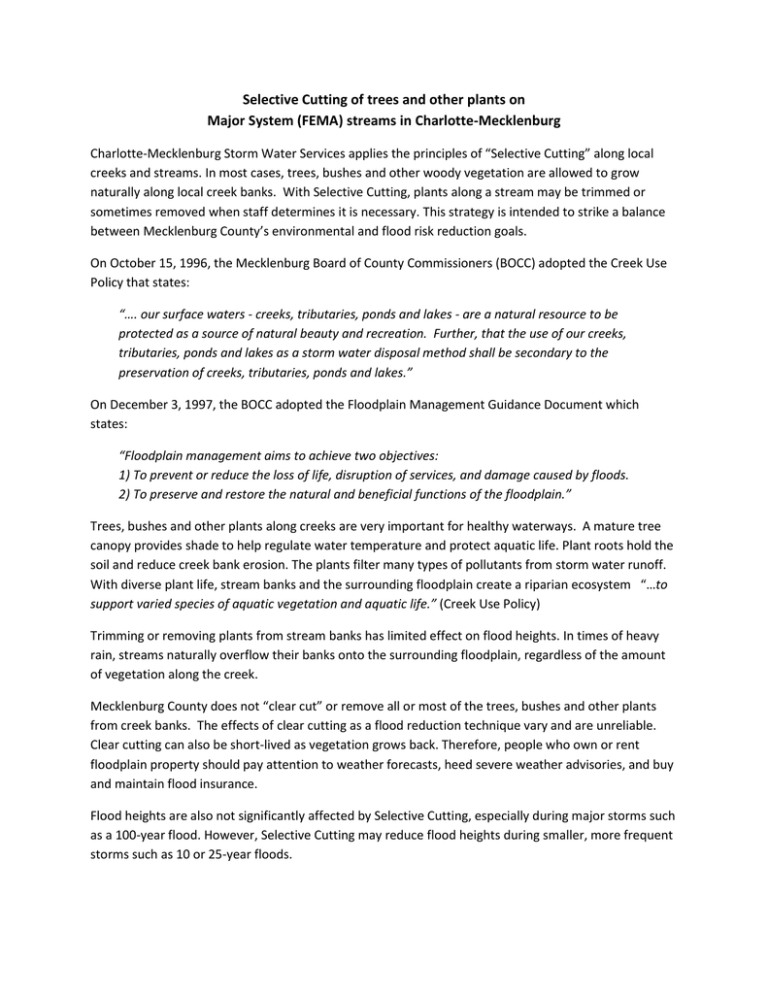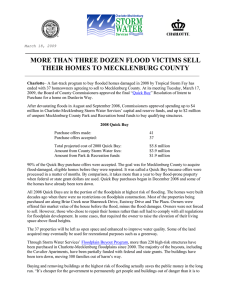Selective Cutting of trees and other plants on
advertisement

Selective Cutting of trees and other plants on Major System (FEMA) streams in Charlotte-Mecklenburg Charlotte-Mecklenburg Storm Water Services applies the principles of “Selective Cutting” along local creeks and streams. In most cases, trees, bushes and other woody vegetation are allowed to grow naturally along local creek banks. With Selective Cutting, plants along a stream may be trimmed or sometimes removed when staff determines it is necessary. This strategy is intended to strike a balance between Mecklenburg County’s environmental and flood risk reduction goals. On October 15, 1996, the Mecklenburg Board of County Commissioners (BOCC) adopted the Creek Use Policy that states: “…. our surface waters - creeks, tributaries, ponds and lakes - are a natural resource to be protected as a source of natural beauty and recreation. Further, that the use of our creeks, tributaries, ponds and lakes as a storm water disposal method shall be secondary to the preservation of creeks, tributaries, ponds and lakes.” On December 3, 1997, the BOCC adopted the Floodplain Management Guidance Document which states: “Floodplain management aims to achieve two objectives: 1) To prevent or reduce the loss of life, disruption of services, and damage caused by floods. 2) To preserve and restore the natural and beneficial functions of the floodplain.” Trees, bushes and other plants along creeks are very important for healthy waterways. A mature tree canopy provides shade to help regulate water temperature and protect aquatic life. Plant roots hold the soil and reduce creek bank erosion. The plants filter many types of pollutants from storm water runoff. With diverse plant life, stream banks and the surrounding floodplain create a riparian ecosystem “…to support varied species of aquatic vegetation and aquatic life.” (Creek Use Policy) Trimming or removing plants from stream banks has limited effect on flood heights. In times of heavy rain, streams naturally overflow their banks onto the surrounding floodplain, regardless of the amount of vegetation along the creek. Mecklenburg County does not “clear cut” or remove all or most of the trees, bushes and other plants from creek banks. The effects of clear cutting as a flood reduction technique vary and are unreliable. Clear cutting can also be short-lived as vegetation grows back. Therefore, people who own or rent floodplain property should pay attention to weather forecasts, heed severe weather advisories, and buy and maintain flood insurance. Flood heights are also not significantly affected by Selective Cutting, especially during major storms such as a 100-year flood. However, Selective Cutting may reduce flood heights during smaller, more frequent storms such as 10 or 25-year floods. With Selective Cutting, Storm Water Services staff can remove certain woody vegetation from major system streams including, but not limited to, the following: in the creek channel (including blockages of any type of debris) having a caliper (diameter) of four inches of less in the “low flow area” (from the normal water surface elevation to approximately halfway up the creek bank.) As part of Mecklenburg County’s Selective Cutting strategy: dredging of creeks is not permitted. Lower limbs and branches of plants on stream banks may be trimmed at the base of the plant or tree trunk to encourage healthy plant growth and minimize snagging of debris. Cut vegetation will be stacked near the top of bank in a way that reduces the chance of the material floating in case of a flood event. Storm Water Services staff determines where Selective Cutting will occur after considering staff observations, customer service requests, amount of growth to be removed, and available funding. To submit a Storm Water Services Customer Service Request for Selective Cutting, please contact Charlotte-Mecklenburg Customer Service at 311.



